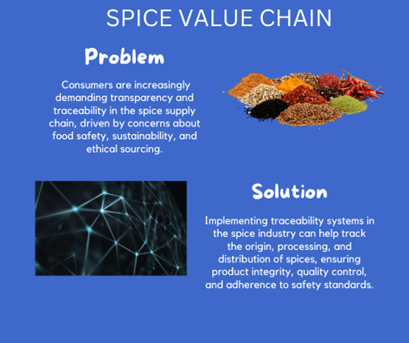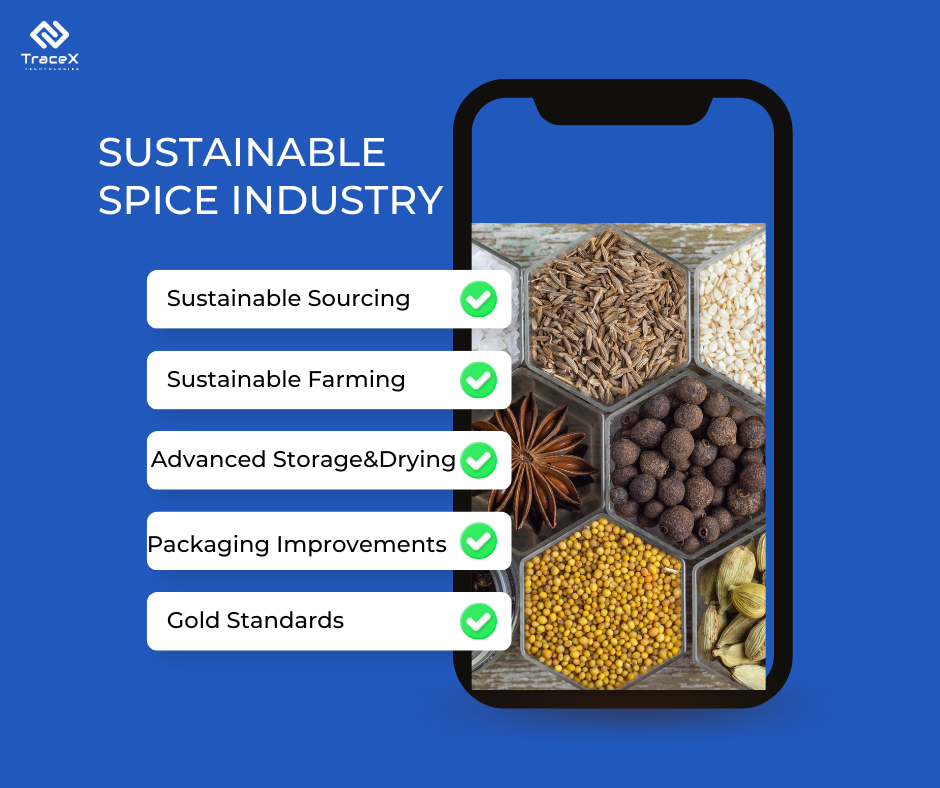Contact: +91 99725 24322 |
Menu
Menu
Quick summary: Explore the importance of traceability in the spice supply chain. Discover how traceability systems enhance transparency, sustainability, and food safety. Learn how advanced technologies like blockchain enable end-to-end traceability, ensuring ethical sourcing and consumer confidence. Uncover the benefits of implementing traceability in the spice industry.

In recent times, the global food industry has experienced a notable transition towards sustainability and traceability in ingredient sourcing. There’s been a surge in the desire for products boasting a transparent spice supply chain, driven by consumers’ heightened awareness of the environmental and social consequences of their buying choices.
As consumers become more conscious of the origins and journey of their food, the spice sector finds itself at the forefront of this shift. With a rich history deeply intertwined with cultures and cuisines worldwide, spices now undergo scrutiny for their ethical and environmental footprint.
Apart from nutritional content, the vast majority (80%) of consumers prioritize additional transparency measures such as allergen details, certifications, and values-based information like animal welfare and fair-trade practices. This change in consumer behaviour has propelled sustainability to the forefront of purchasing decisions for a considerable segment of the market.
Indian tradition is truly entwined with spices and this makes it the home for spices. Spice adds flavour and aroma to food and also serves as a seasoning agent. India is the world’s largest producer and consumer of spices. It has a domestic trade value of USD 1 billion and an export value of USD 3 billion, which necessitates a robust spice supply chain.
India produces a wide variety of spices like chilly, ginger, turmeric, garlic, black pepper, cardamom, cumin, and other tree products. Spice production in India is done by millions of smallholder farmers and it serves as a livelihood for the rural population. The diverse Agro-climatic conditions favour the production of a variety of spices, a few of them distinctive to geography. Spices are normally traded in whole form, powdered form, as oils and extracts. They are used in food, pharmaceuticals, fragrances, and cosmetics. They are widely used in ready-to-eat food, packaged meat and seafood, and soups and sauces. Spices are produced in many developing countries, with China being a major competitor.
India is a leading supplier of crushed pepper, turmeric, spice mixture, and oils. India accounts for two-thirds of global trade in these spice commodities. 85% of the spice trade involves the sale of whole unprocessed raw materials. Both in the EU and US, about 60% of traded spices are used by processors, who have a distinctive requirement for quality, taste, and colour. The demand is linked to dietary changes and dynamics in the processing industry. With new cuisines, the demand for seasoned food is high.
1. External Risks: External factors like unpredictable weather conditions, geopolitical events, and regulatory changes can disrupt the spice supply chain by affecting crop yields, trade routes, and import/export processes.
2. Internal Challenges: Internal factors such as unreliable suppliers, transportation bottlenecks, and quality control issues pose significant risks to the spice supply chain’s efficiency and reliability.
3. Supplier Reliability: Ensuring the reliability and consistency of suppliers is crucial for mitigating supply chain risks. However, identifying and managing reliable suppliers who meet strict quality standards and ethical sourcing practices can be challenging.
4. Geographic Dependency: Dependency on a single geographic region or supplier increases vulnerability to supply disruptions caused by natural disasters, political instability, or trade conflicts. Diversification of suppliers and sourcing from multiple regions can help mitigate this risk.
5. Quality Control: Maintaining consistent product quality and safety is paramount in the spice supply chain. The presence of residue levels in spices poses significant challenges in the spice supply chain. Residues can originate from various sources, including pesticides, fertilizers, and environmental contaminants. These residues not only affect the quality and safety of spices but also raise concerns regarding consumer health and regulatory compliance. Without proper measures in place, the presence of high residue levels can lead to rejected shipments, loss of market access, and damage to brand reputation. Implementing stringent quality control measures and regular testing of raw ingredients are essential to identify and address deviations from quality standards.
6. Communication and Collaboration: Effective communication and collaboration among supply chain stakeholders are critical for detecting and resolving potential disruptions promptly. However, achieving seamless communication and collaboration can be challenging, especially across multiple entities in the supply chain.

To begin, it’s crucial to grasp the concept of sustainability within the spices and seasonings sector. Sustainability entails an operational framework that benefits all stakeholders involved, including spice producers, buyers, processors, retailers, consumers, and the environment. This model operates by ensuring that buyers commit to paying fair prices for spices, thereby providing farmers with equitable compensation and encouraging the production of better-quality spices without the need for harmful pesticides. In turn, this fosters investment in modern production equipment and discourages unsustainable growing practices.
The imperative for spice businesses to prioritize sustainable sourcing is multifaceted. Not only does it help maintain a global supply of high-quality spices by discouraging detrimental farming methods, but it also ensures compliance with tightening sustainability regulations in Western countries. Additionally, consumer expectations are evolving, with an increasing demand for products sourced and grown sustainably. Consequently, proving sustainability credentials has become essential for businesses to retain consumer trust and loyalty.
So, how can spice businesses strive to produce fairer, higher quality products sustainably? Despite feeling somewhat powerless, especially in Europe and North America, these businesses play a crucial role in shaping the future of the global spice market. Committing to sustainable sourcing not only aligns with ethical values but also presents tangible benefits, such as the ability to market spices as premium products, thus potentially increasing profits and resonating with conscientious consumers.
The challenge lies in identifying sustainable sourcing options. Fortunately, progress has been made through partnerships between large companies, industry bodies, and farmers, particularly in Asia. By sourcing from approved suppliers that remunerate farmers fairly, both large and small buyers can contribute to this growing movement. Leveraging technology, such as food traceability software, can further support these endeavours by certifying commitments to sustainable sourcing in supplier agreements.
Several sustainability programs have proven effective within the spices industry. For instance, the Sustainable Spices Initiative collaborates with thousands of small-holder spice farmers in India, while the Fairtrade Foundation has expanded its reach to include herb and spice production. These initiatives underscore the industry’s collective efforts towards a more sustainable and equitable future.

Blockchain traceability solutions offer a comprehensive approach to addressing various challenges in the spice supply chain:
End-to-End Visibility: Blockchain technology provides a transparent and immutable ledger of transactions, enabling end-to-end visibility across the entire spice supply chain. Each transaction, from farm to table, is recorded on the blockchain, allowing stakeholders to track the journey of spices in real-time and identify potential bottlenecks or issues.
Quality Assurance with Tracking of Residual Levels for Export Compliance: Blockchain enables the monitoring and tracking of residual levels in spices, ensuring compliance with export regulations and quality standards. By securely recording data on pesticide use, chemical treatments, and other factors, blockchain technology facilitates quality assurance and helps exporters demonstrate compliance with stringent export requirements.
Supply Chain Efficiency: Blockchain streamlines supply chain processes by automating documentation, reducing paperwork, and minimizing manual errors. Smart contracts on the blockchain can automate tasks such as payment processing, quality inspections, and logistics management, thereby improving overall supply chain efficiency and reducing operational costs.
Ethical Sourcing: Blockchain traceability solutions promote ethical sourcing practices by providing transparency into the origin and production practices of spices. By recording information such as farming methods, labour practices, and certifications on the blockchain, stakeholders can ensure that spices are sourced ethically and sustainably, without the use of child labour or harmful chemicals.
Consumer Trust: Blockchain enhances consumer trust by providing transparent and verifiable information about the spices they purchase. Consumers can access detailed information about the origin, quality, and journey of spices by scanning QR codes or accessing blockchain-enabled platforms. This transparency builds trust and confidence in the integrity and safety of spice products, ultimately leading to increased consumer loyalty and satisfaction.
TraceX blockchain traceability solutions revolutionize the spice supply chain by offering unparalleled transparency and accountability. With TraceX, stakeholders can track spices from farm to table, ensuring end-to-end visibility and enabling swift identification of any issues or bottlenecks. Moreover, TraceX facilitates quality assurance by meticulously tracking residual levels in spices, ensuring compliance with export regulations and quality standards. By streamlining supply chain processes and promoting ethical sourcing practices, TraceX enhances efficiency and fosters trust among consumers. With TraceX, stakeholders can access verifiable information about the origin, quality, and journey of spices, empowering them to make informed decisions and build a more sustainable and ethical spice industry.
In conclusion, traceability in the spice supply chain is no longer just a concept; it’s a necessity for ensuring transparency, quality, and sustainability. Through innovative solutions like TraceX blockchain traceability, stakeholders can navigate the complexities of the spice supply chain with confidence. By embracing traceability, spice companies can uphold ethical sourcing practices, comply with regulations, and build trust with consumers. Ultimately, traceability not only safeguards the integrity of the spice supply chain but also paves the way for a brighter, more sustainable future for the industry.
